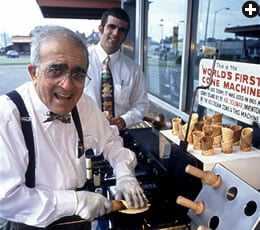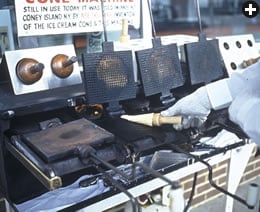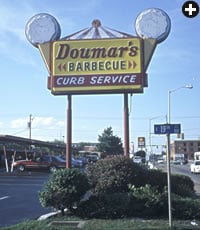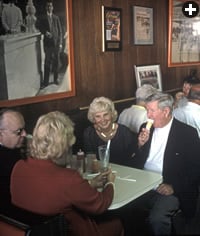

"That's a
great story!" I thought. "But is that really how it happened?"
Activities
There are no
photographs of Ernest Hamwi. Nor is there any record of his booth or, for that
matter, of his existence in St. Louis. Indeed, says Ellen Thomasson, curatorial
assistant for the Missouri Historical Society, "There were several claims
to the invention of the ice-cream cone at the fair, all made many years after
the fact. As far as we can tell, not one has been definitely proved."
 |
| "Come on over! Our ice-cream cones will melt in your mouth!" says 88-year-old Albert Doumar. He should know. He's been making zalabia cones for decades on the same machine his Uncle Abe built in 1905. |
Nor do zalabia hail from the Arabian Gulf region.
Historically, they are Levantine, popular in Syria, Lebanon and parts of Iraq
and Turkey. And they are not made on a waffle iron. Actually, they're flatter
than waffles and most resemble Italian pizzelle. Like the pizzelle, they have a grid pattern on their
surface. There is another, very different, zalabia that is served in North
Africa. It is made of looping, pretzel-like strands of deep-fried batter that are
smothered in honey or syrup and often tinted a garish orange.
But back to
Hamwi and his zalabia. He and his wife, the story goes, took their meager
life's savings and invested them in a zalabia booth at the Louisiana Purchase
Exposition, also called the 1904 World's Fair. The fair covered some 500
hectares (1235 acres) and highlighted recent inventions, including the
airplane, invented the year before; the radio; the telephone switchboard; and
the silent movie. It also housed palaces, halls and pavilions displaying the
wonders and delights of the world. More than 18 million visitors passed through
the Exposition during its seven-month run, and there were also scores of
vendors offering much to eat.
The Hamwis, like
many other immigrants from the Levant, were trying to bring to the US the
crisp, round, cookie-like snack that was so popular back home. The zalabia were
baked between two iron platens (flat metal plates), each about the size of a
dinner plate. The platens were hinged together and held by a handle over a
charcoal fire. Once cooked, the zalabia were sprinkled with sugar and served.
 |
| "Quickly does it!" With a twist of the hand, a zalabia is rolled into a cone around a wooden form. Each thin pastry must be shaped while it is hot and pliable. As it cools, it hardens and is ready to hold a scoop of ice cream. |
Ernest Hamwi's
booth was next to one of the some 50 ice-cream stands at the fair. Just who
owned the stand is unclear, but whoever he was, his ice cream sold faster than
Hamwi's zalabia—so fast, in fact, that one day he ran out of clean glass cups.
At that moment, some say, the ice-cream man saw the possibilities of the
zalabia; others claim the zalabia man saw the possibilities of the ice cream.
Hamwi's story
is largely based on a letter he wrote in 1928 to the Ice Cream Trade Journal, long after he had established the
Cornucopia Waffle Company. By the late 1920’s, the ice-cream cone industry in
the US was producing some 250 million cones a year. Despite the lack of detail
in Hamwi's account, cookbooks today generally credit him as the first
ice-cream-cone maker. In fact, the International Association of Ice Cream Manufacturers
recognizes his claim.
There are,
however, other stories. All involve the same setting, characters and plot: a
1904 Exposition ice-cream vendor who runs out of cups and a vendor (Syrian or
Turkish—the terms were roughly interchangeable at the time) who saves the day
with a combination of zalabia and ambition.
One of these
stories is about Abe Doumar.
We know more
about Abe Doumar than about Ernest Hamwi, thanks to Abe's nephew Albert, who at
age 88 is the owner of Doumar's Cones and Barbecue in Norfolk, Virginia. Like
Hamwi, Abe Doumar came to the United States from Syria. At age 15 he sailed to
the US on a third-class ticket and soon found work as a souvenir salesman at
fairs around the country. In 1904, he was in his early 20's. At the Exposition,
he sold souvenirs by day and, at night, joined the zalabia salesmen along the
Exposition's entertainment promenade.
 |
| "Welcome to Doumar's"―this restaurant has been welcoming visitors to Norfolk, Virginia, ever since Abe Doumar brought his cone-making machine to the Jamestown Exposition there in 1907. |
Abe told Albert
that it was at the fair that he took a zalabia and rolled it into a cone, much
as he had been accustomed to do with round pieces of flatbread in Syria when
making a sandwich. But instead of bread, this was zalabia, and instead of
filling the cone with slices of meat or falafel (fried balls of chickpeas or field beans), he added ice cream to make what he
called "a kind of Syrian ice-cream sandwich." Abe shared the idea
freely among the vendors, he said, and it was in this way that the "invention"
spread from stand to stand. If you travel to the Middle East today, you'll see
street vendors selling cone-shaped flatbread sandwiches that are eaten much
like ice-cream cones.
After the
Exposition, Abe went to North Bergen, New Jersey. There, he developed what he
believed was his invention into a four-iron machine that made zalabia that
could be rolled into cones. In 1905, he opened ice-cream stands at Coney Island
and "Little Coney Island" in North Bergen. Two years later, he left
others to operate them while he moved to Norfolk, Virginia, ahead of the 1907
Jamestown (Virginia) Exposition. As he prospered, he brought his parents and
three brothers to the US from Syria. Today, many family members still reside in
Norfolk, where Doumar's restaurant has become something of a local legend. In
2001, the website Citysearch.com named Doumar's Cones and Barbecue one of the
two best "comfort food" restaurants in Norfolk. Some mornings, Albert
still runs the more than century-old cone machine that cooks each zalabia for
one minute between the cast-iron platens. The zalabia is then removed, rolled
into a cone around a wooden form and allowed to cool and harden until
crispy—all at a speed of some 200 cones per hour.
 |
| "It's a great family business, and I'm proud to be part of it," says Thaddeus Doumar. His great-uncle Abe claimed to have suggested the ice-cream cone in 1904. Today, Thaddeus helps manage the family cones and barbecue restaurant in Norfolk, Virginia. |
But Hamwi and
Doumar are not the only contenders for the title of Inventor of the Ice-Cream
Cone. Nick Kabbaz, president of the St. Louis Ice Cream Cone Company, claimed
to have worked for Hamwi years earlier and said that the invention was actually
his idea. David Avayou, a Turkish immigrant who owned ice-cream shops in
Atlantic City, New Jersey, said that he had seen paper ice-cream cones in
France and adapted the idea—but with edible materials—at the 1904 Exposition.
Charles
Menches, the ice-cream vendor who claimed to have worked in the stand next to
Hamwi's, said he was the first to have rolled zalabia cones, and that he made
two of them for a lady friend: one as a container for flowers, and the other
for ice cream.
 |
| "Enjoy!" would be the first word Abe Doumar would say if could walk out of the picture and sit with this patron enjoying a zalabia ice-cream cone, just off the machine he invented. |
Finally, there
is Italo Marchiony of New York, who filed a patent for "small pastry cups
with sloping sides" the year before the 1904 Exposition. But the bottoms
of his cups were flat, not conical, and thus his post-Exposition claim that the
cone manufacturers were violating his patent melted under the hot gaze of the
law.
It is, in the
end, something of a toss-up. Alixa Naff, donor and archivist of the
Smithsonian's Naff Arab-American Collection, told The Virginia Post that
"there was no way I could literally refute Mr. Albert Doumar's statement
that his uncle invented the ice-cream cone. ...It is such a simple technique
that it may have occurred to other people at other places at about the same
time. I have accepted Mr. Doumar's statement, keeping in mind, however, that
possibility."
But, no matter
how you roll the zalabia, the
tales of its use as an ice-cream cone are now part of American folklore. Although
the historical accuracy of its invention may be in doubt, the creative
brilliance that joined two ideas from two parts of the world and made from them
a national cooking symbol is not. What could be more American than that?
click here to view the original article
| Jack Marlowe taught English
literature in California and Greece and served as a high-school administrator
in the San Francisco Bay Area and, under Fulbright sponsorship, in India and
Egypt. |
| David Alan
Harvey was National Geographic staff
photographer from 1978—the year he was named Magazine Photographer of the
Year—until 1986. Now a free-lancer, he is a member of the photographic
cooperative Magnum Photos. |
STANDARDS
This lesson correlates to the following national standards for world history and language arts, established by MCREL at http://www.mcrel.org/:
- Understands patterns of immigrant life after 1870 (e.g., where people came from and where they settled; how immigrants formed a new American culture; the challenges, opportunities, and contributions of different immigrant groups; ways in which immigrants learned to live and work in a new country)
- Gathers and uses information for research purposes
- Demonstrates competency in the general skills and strategies of the writing process





